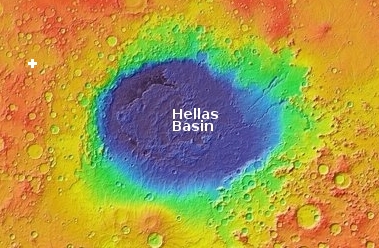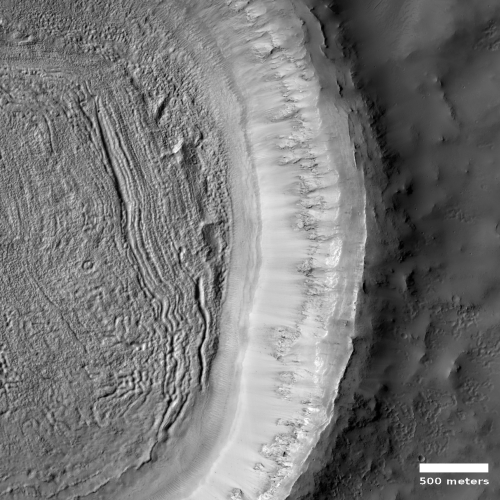Glacial features in a Mars crater at 29 degrees south latitude?
Cool image time! The photo to the right, cropped and reduced to post here, was taken on January 2, 2022 by the high resolution camera on Mars Reconnaissance Orbiter (MRO). Simply labeled “slope features,” it was likely taken to monitor the gullies and streaks on the interior walls of this 4-mile-wide crater. Scientists have been using MRO to track the coming and going of frost on this crater’s interior walls since 2016.
Equally intriguing however are what appear to be squashed layers within the crater’s interior. These appear to be some form of glacial feature created by repeated climate cycles, similar to the glacial features routinely seen throughout the 30 to 60 degree mid-latitude strips north and south.
What makes the glacial features in this particular crater particularly intriguing is its location, as shown in the overview map below.

The white cross marks the crater’s location, about 600 miles northwest from the edge of Hellas Basin, the death valley of Mars. More important, the crater sits at 29.8 degrees south latitude, which makes it one of the closest points to the equator where glacial features have been seen.
Elevation probably plays a part in allowing ice to form in this equatorial crater. While it is at a latitude where little or no ice is generally spotted, it is also in the midst of the southern cratered highlands, at an altitude about 20,000 feet higher than the northern lowland plains.
On Christmas Eve 1968 three Americans became the first humans to visit another world. What they did to celebrate was unexpected and profound, and will be remembered throughout all human history. Genesis: the Story of Apollo 8, Robert Zimmerman's classic history of humanity's first journey to another world, tells that story, and it is now available as both an ebook and an audiobook, both with a foreword by Valerie Anders and a new introduction by Robert Zimmerman.
The print edition can be purchased at Amazon or from any other book seller. If you want an autographed copy the price is $60 for the hardback and $45 for the paperback, plus $8 shipping for each. Go here for purchasing details. The ebook is available everywhere for $5.99 (before discount) at amazon, or direct from my ebook publisher, ebookit. If you buy it from ebookit you don't support the big tech companies and the author gets a bigger cut much sooner.
The audiobook is also available at all these vendors, and is also free with a 30-day trial membership to Audible.
"Not simply about one mission, [Genesis] is also the history of America's quest for the moon... Zimmerman has done a masterful job of tying disparate events together into a solid account of one of America's greatest human triumphs."--San Antonio Express-News
Cool image time! The photo to the right, cropped and reduced to post here, was taken on January 2, 2022 by the high resolution camera on Mars Reconnaissance Orbiter (MRO). Simply labeled “slope features,” it was likely taken to monitor the gullies and streaks on the interior walls of this 4-mile-wide crater. Scientists have been using MRO to track the coming and going of frost on this crater’s interior walls since 2016.
Equally intriguing however are what appear to be squashed layers within the crater’s interior. These appear to be some form of glacial feature created by repeated climate cycles, similar to the glacial features routinely seen throughout the 30 to 60 degree mid-latitude strips north and south.
What makes the glacial features in this particular crater particularly intriguing is its location, as shown in the overview map below.

The white cross marks the crater’s location, about 600 miles northwest from the edge of Hellas Basin, the death valley of Mars. More important, the crater sits at 29.8 degrees south latitude, which makes it one of the closest points to the equator where glacial features have been seen.
Elevation probably plays a part in allowing ice to form in this equatorial crater. While it is at a latitude where little or no ice is generally spotted, it is also in the midst of the southern cratered highlands, at an altitude about 20,000 feet higher than the northern lowland plains.
On Christmas Eve 1968 three Americans became the first humans to visit another world. What they did to celebrate was unexpected and profound, and will be remembered throughout all human history. Genesis: the Story of Apollo 8, Robert Zimmerman's classic history of humanity's first journey to another world, tells that story, and it is now available as both an ebook and an audiobook, both with a foreword by Valerie Anders and a new introduction by Robert Zimmerman.
The print edition can be purchased at Amazon or from any other book seller. If you want an autographed copy the price is $60 for the hardback and $45 for the paperback, plus $8 shipping for each. Go here for purchasing details. The ebook is available everywhere for $5.99 (before discount) at amazon, or direct from my ebook publisher, ebookit. If you buy it from ebookit you don't support the big tech companies and the author gets a bigger cut much sooner.
The audiobook is also available at all these vendors, and is also free with a 30-day trial membership to Audible.
"Not simply about one mission, [Genesis] is also the history of America's quest for the moon... Zimmerman has done a masterful job of tying disparate events together into a solid account of one of America's greatest human triumphs."--San Antonio Express-News


